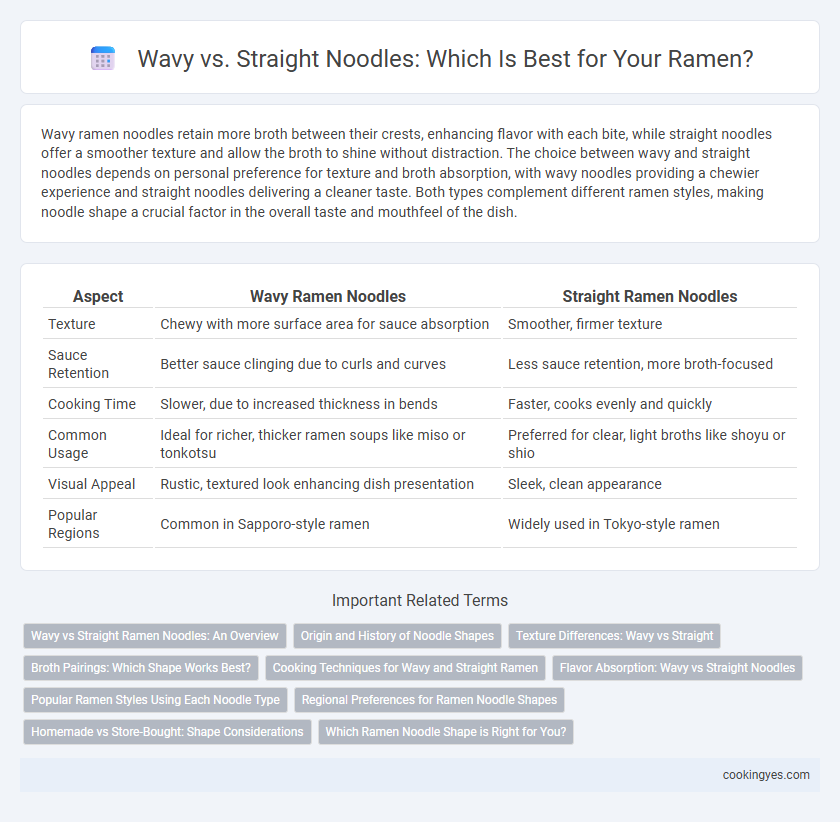Wavy ramen noodles retain more broth between their crests, enhancing flavor with each bite, while straight noodles offer a smoother texture and allow the broth to shine without distraction. The choice between wavy and straight noodles depends on personal preference for texture and broth absorption, with wavy noodles providing a chewier experience and straight noodles delivering a cleaner taste. Both types complement different ramen styles, making noodle shape a crucial factor in the overall taste and mouthfeel of the dish.
Table of Comparison
| Aspect | Wavy Ramen Noodles | Straight Ramen Noodles |
|---|---|---|
| Texture | Chewy with more surface area for sauce absorption | Smoother, firmer texture |
| Sauce Retention | Better sauce clinging due to curls and curves | Less sauce retention, more broth-focused |
| Cooking Time | Slower, due to increased thickness in bends | Faster, cooks evenly and quickly |
| Common Usage | Ideal for richer, thicker ramen soups like miso or tonkotsu | Preferred for clear, light broths like shoyu or shio |
| Visual Appeal | Rustic, textured look enhancing dish presentation | Sleek, clean appearance |
| Popular Regions | Common in Sapporo-style ramen | Widely used in Tokyo-style ramen |
Wavy vs Straight Ramen Noodles: An Overview
Wavy ramen noodles have a textured surface that helps absorb more broth, enhancing flavor in traditional Japanese miso or shoyu ramen. Straight ramen noodles provide a firm bite and a smooth texture, commonly paired with clear broths like shio or tonkotsu. The choice between wavy and straight noodles affects the overall mouthfeel and broth retention of the dish.
Origin and History of Noodle Shapes
Wavy ramen noodles originated in the Sapporo region of Hokkaido, where the curly texture was designed to hold thicker, richer miso-based broths common in colder climates. Straight noodles, associated with Tokyo-style ramen, reflect the historical preference for lighter, soy-based shoyu soups and quicker cooking times. The distinct noodle shapes evolved to complement regional broth flavors and cooking traditions, shaping ramen's diverse culinary heritage across Japan.
Texture Differences: Wavy vs Straight
Wavy ramen noodles offer a chewier and more textured bite due to their uneven surface, which allows broth to cling better, enhancing each mouthful's flavor. Straight noodles deliver a smoother, silkier texture with a firmer consistency, providing a clean, straightforward taste experience that highlights the soup's richness. The choice between wavy and straight noodles impacts the overall mouthfeel and flavor release, making texture a key factor in ramen enjoyment.
Broth Pairings: Which Shape Works Best?
Wavy ramen noodles are ideal for rich, thick broths like miso or tonkotsu because their undulating texture traps more sauce, enhancing each bite with robust flavor. Straight noodles pair best with lighter, clearer broths such as shoyu or shio, as their sleek shape allows the delicate broth to shine without overwhelming the palate. Selecting the right noodle shape optimizes flavor absorption and mouthfeel, tailoring the ramen experience to the broth's unique characteristics.
Cooking Techniques for Wavy and Straight Ramen
Wavy ramen noodles hold sauce and broth more effectively due to their textured surface, making them ideal for rich, thicker soups that benefit from enhanced flavor absorption. Straight ramen noodles cook uniformly and quickly, perfect for clear, light broths where a clean, firm bite is preferred. Mastering cooking times for both types ensures optimal texture: wavy noodles require slightly longer simmering to soften curves, while straight noodles need precise timing to maintain firmness without becoming mushy.
Flavor Absorption: Wavy vs Straight Noodles
Wavy ramen noodles offer enhanced flavor absorption due to their increased surface area and texture, which allows soup and seasonings to cling better compared to straight noodles. Straight noodles have a smoother texture that results in a lighter flavor coating, making them ideal for broth-focused ramen styles. Choosing wavy noodles intensifies every bite with richer, more robust flavors as the waves trap more seasoning and broth.
Popular Ramen Styles Using Each Noodle Type
Wavy ramen noodles are prominently featured in Sapporo-style miso ramen, where their texture holds thick, rich broth effectively. Straight noodles are commonly used in Hakata-style tonkotsu ramen, prized for their quick cooking time and ability to deliver a creamy pork bone broth directly to the palate. Both noodle types enhance specific regional ramen varieties by complementing distinct soup bases and preparation techniques.
Regional Preferences for Ramen Noodle Shapes
Wavy ramen noodles are favored in regions like Hokkaido, where their texture helps trap rich miso broths, enhancing flavor absorption. Straight noodles are prevalent in Tokyo-style ramen, valued for their firm bite and ability to complement clear soy-based broths. Regional preferences reflect how noodle shape influences the interaction with local broth styles, shaping distinctive ramen experiences across Japan.
Homemade vs Store-Bought: Shape Considerations
Wavy ramen noodles tend to hold broth and sauces better, making them a popular choice for homemade recipes where flavor absorption is key, while straight noodles offer a smoother texture and are often preferred in store-bought varieties for their uniformity and ease of packaging. Homemade wavy noodles require skillful dough handling and cutting techniques to achieve the characteristic ripples, whereas straight noodles are typically produced with machines for consistent thickness and shape. The choice between wavy and straight noodles significantly impacts the eating experience, with homemade wavy noodles enhancing flavor retention and store-bought straight noodles providing convenience and a lighter mouthfeel.
Which Ramen Noodle Shape is Right for You?
Wavy ramen noodles excel at holding rich, thick broths, making them ideal for miso or tonkotsu ramen due to their texture that traps flavor effectively. Straight noodles provide a smoother, cleaner bite best suited for lighter, clearer broths like shoyu or shio ramen, allowing the broth's subtle taste to shine. Choosing between wavy and straight shapes depends on your preferred broth intensity and noodle texture for the ultimate ramen experience.
Wavy vs straight for ramen noodles Infographic

 cookingyes.com
cookingyes.com